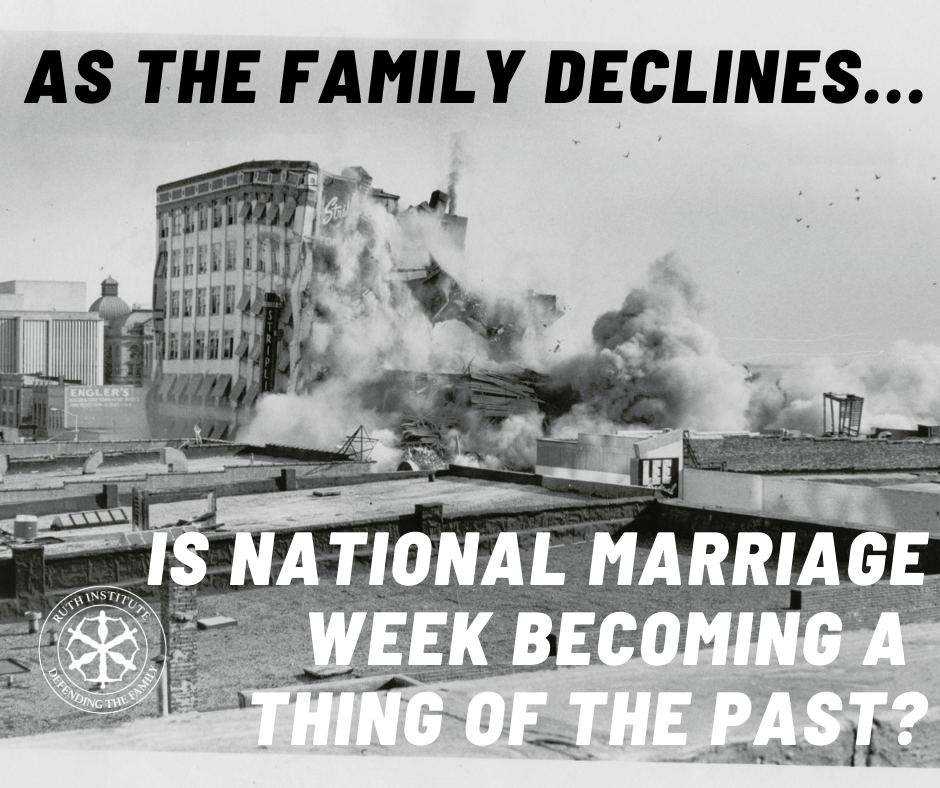In America, nuptials are fast becoming obsolete

By Don Feder – – Monday, February 14, 2022
Originally published in The Washington Times
OPINION:
As we end National Marriage Week (Feb. 7-14), is it unreasonable to ask if we’ll be celebrating it in five years — or in 10?
There’s no way to sugarcoat it: Marriage is fast becoming obsolete in America. In 1970, 70% of American adults were married. By 2018, that figure had fallen to 50%.
It gets worse. Among adults in their prime childbearing years (18 to 24), 45% were married in 1960, compared to only 9% today.
We’re marrying later in life and having fewer children. Increasingly, we’re not marrying at all. Perhaps that’s why our fertility rate is now well below replacement — currently 1.78, with 2.1 the number of children the average woman must have in her lifetime to replace the current population.
In 1968, 13% of children lived with an unmarried parent; today, it’s nearly one-third. You can see the consequences in the schools and the streets.
Opinion polls bolster these findings.
According to a Pew Research survey, among 18-to-25-year-olds, 78% believe cohabitation is acceptable, even if the parties don’t plan to marry later on. In a December 2020 Gallup survey, only 29% said it was very important for a couple to marry to have children — down from 38% in 2013.
One of the strongest cases for marriage comes from an unlikely source. In an opinion piece published in 2010, 1970s sex symbol Raquel Welch wrote: “I’m ashamed to admit that I myself have been married four times, and yet I still feel that it (marriage) is the cornerstone of civilization, an essential institution that stabilizes society, provides a sanctuary for children and saves us from anarchy.” Now that’s the type of sex education that should be taught in our schools.
Married couples are happier, healthier and better off financially than their unmarried counterparts. Being single has been called one of the greatest health risks people can voluntarily take. Husbands and wives are 10% and 15% less likely to die prematurely than the unmarried.
They’re also safer. In a 2012 report, DOJ’s National Crime Victimization Survey found that the rate of victimization was 13.5 per 1.000 for those who were married, 37.0 for the divorced and 40.7 for individuals who have never been married.
On every index, children who grow up in a family with their married, biological parents are better off — less likely to drop out of school, commit crimes, abuse drugs and alcohol and engage in sexual activity at an early age.
The what is easy. The why is more complicated.
For more than half a century, there has been a relentless war on marriage. Adolescents have been told they don’t have to marry to have sex or even live together.
Marriage has been described as the relic of a bygone era. Opponents ask: How can words spoken at a ceremony and names on a piece of paper somehow “sanctify” a union and ensure bliss?
The increasing popularity of marriage substitutes — including cohabitation, domestic partnerships and same-sex unions — further undermines marriage. Last year, Cambridge, Massachusetts (home of Harvard University), took the next logical step by redefining domestic partnerships to include two or more unrelated individuals. Can polygamy be far behind?
Professor Robert George of Princeton University says that historically, marriage has required permanence, fidelity and exclusivity. For good measure, throw in complementarity — the union of males and females.
More than politics, popular culture has changed attitudes about marriage. Once upon a time, even married couples couldn’t be shown in bed together in movies. TV sitcoms of the 1950s featured intact families — like “Father Knows Best,” “The Donna Reed Show” and “Ozzie and Harriett” — bound by love and tradition.
“The Mary Tyler Moore Show” celebrated singleness, and “One Day at a Time” single-parenting, while “Married With Children” presented the grotesquely dysfunctional as typical. Today, the nuclear family is an endangered species. A happy exception is the Netflix reboot of “Lost in Space.”
In the 1950s, viewers wanted normalcy. Today, Hollywood pushes the aberrant, the bizarre and the downright ugly. Is it so surprising? Movies are made by people on their third marriage, with a few potential harassment suits lurking in the background.
Real marriage is good for couples, children and society and essential if we’re to have a future. However, if we want to keep it, we’ll have to fight for it.
Maybe National Marriage Week should be renamed Stand Up for Marriage Week. Stand up against an army of detractors, marriage alternatives and increasingly hostile culture.
• Don Feder is a former Boston Herald writer and syndicated columnist.
Copyright © 2022 The Washington Times, LLC. Click here for reprint permission.
About the Ruth Institute
The Ruth Institute is a global non-profit organization, leading an international interfaith coalition to defend the family and build a civilization of love.
Jennifer Roback Morse has a Ph.D. in economics and has taught at Yale and George Mason University. She is the author of The Sexual State and Love and Economics – It Takes a Family to Raise a Village.
To schedule an interview with Dr. Morse, contact media@ruthinstitute.org.



In addition to reducing suicide‘s, has SOCE been shown to help young people with their sexual orientation/identification?